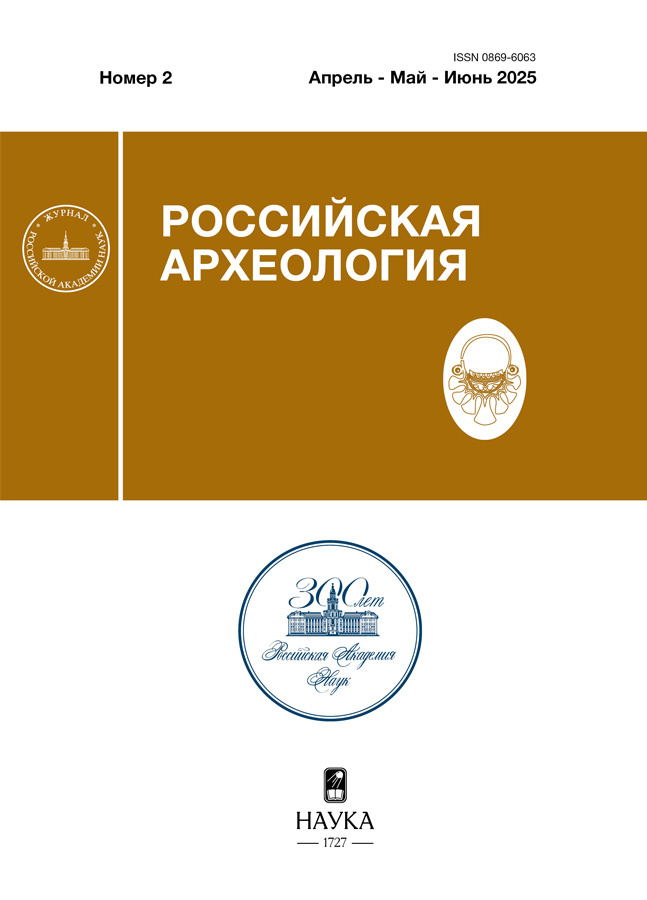Жертвенный комплекс раннего железного века на могильнике Тартас-2 в Барабинской лесостепи: радиоуглеродная хронология и данные изотопного анализа
- Авторы: Мыльникова Л.Н.1, Молодин В.И.1, Пархомчук Е.В.2, Меньшанов П.Н.2, Ненахов Д.А.1, Бабина К.А.1, Ершова О.В.1
-
Учреждения:
- Институт археологии и этнографии СО РАН
- Новосибирский государственный университет
- Выпуск: № 4 (2024)
- Страницы: 50-61
- Раздел: СТАТЬИ
- URL: https://transsyst.ru/0869-6063/article/view/655808
- DOI: https://doi.org/10.31857/S0869606324040048
- EDN: https://elibrary.ru/KJFJAV
- ID: 655808
Цитировать
Полный текст
Аннотация
Статья представляет результаты радиоуглеродного датирования и данные изотопного анализа объектов жертвенного комплекса из кургана раннего железного века в Барабинской лесостепи. Жертвенник выявлен в насыпи кургана 7 могильника Тартас-2 и представлен останками шести человек, черепами 33 лошадей, трех овец, двух коров. Кости людей и животных связаны с земляным сооружением – насыпью, зафиксированы на уровне 2 и 3 горизонтов ее выборки. Расположены у внутренней границы рва, в полах насыпи, дублируя ее склон. Сверху кости животных и людей были засыпаны последним слоем земли. Радиоуглеродный анализ предполагает единовременность события, произошедшего между 650–550 гг. до н.э. (p =0.0009). Образцы коллагена костей погребенных людей и животных имеют средние значения изотопных сдвигов, δ13C и δ15N, характерные для млекопитающих с преимущественной наземной пищей. Подобный жертвенник впервые зафиксирован для погребального обряда населения восточного региона предположительно саргатской культуры.
Полный текст
Об авторах
Л. Н. Мыльникова
Институт археологии и этнографии СО РАН
Автор, ответственный за переписку.
Email: L.mylnikova@yandex.ru
Россия, Новосибирск
В. И. Молодин
Институт археологии и этнографии СО РАН
Email: Molodin@archaeology.nsc.ru
Россия, Новосибирск
Е. В. Пархомчук
Новосибирский государственный университет
Email: evparkhom@yandex.ru
Россия, Новосибирск
П. Н. Меньшанов
Новосибирский государственный университет
Email: menshanov@nsu.ru
Россия, Новосибирск
Д. А. Ненахов
Институт археологии и этнографии СО РАН
Email: nenaxoffsurgut@mail.ru
Россия, Новосибирск
К. А. Бабина
Институт археологии и этнографии СО РАН
Email: sashkina_kseniya@mail.ru
Россия, Новосибирск
О. В. Ершова
Институт археологии и этнографии СО РАН
Email: ersholesya198q@gmail.com
Россия, Новосибирск
Список литературы
- Корякова Л.Н. Ранний железный век Зауралья и Западной Сибири. Свердловск, 1988. 239 с.
- Матвеева Н.П. Саргатская культура на Среднем Тоболе. Новосибирск: Наука, 1993. 174 с.
- Матвеева Н.П. Ранний железный век Приишимья. Новосибирск: Наука, 1994. 151 с.
- Матвеева Н.П. Социально-экономические структуры древнего населения Западной Сибири (ранний железный век лесостепной и подтаежной зон): автореф. дис. … д-ра ист. наук. Новосибирск, 1998. 45 с.
- Матвеева Н.П. Социально-экономические структуры населения Западной Сибири в раннем железном веке (лесостепная и подтаежная зоны). Новосибирск: Наука, 2000. 400 с.
- Могильников В.А. Население Верхнего Приобья в середине – второй половине I тысячелетия до н.э. М.; Пущино: Пущинский науч. центр РАН, 1997. 196 с.
- Мыльникова Л.Н., Васильев С.К., Молодин В.И. и др. К изучению погребальной практики элитных курганов саргатской культуры Барабинской лесостепи (сопроводительные комплексы животных в кургане 7 могильника Тартас-2 // Полевые исследования в Верхнем Приобье, Прииртышье и на Алтае (археология, этнография, устная история и музееведение): сб. науч. тр. Вып. 18 / Ред. М.А. Демин и др. Барнаул: Алтайский гос. пед. ун-т, 2023. С. 161–170.
- Мыльникова Л.Н., Молодин В.И., Дураков И.А. и др. Начало исследования элитного кургана 7 саргатской культуры на памятнике Тартас-2 в Барабинской лесостепи. Геофизические исследования и элементы обрядовой практики // Проблемы археологии, этнографии и антропологии Сибири и сопредельных территорий. Т. XXIX. Новосибирск: Изд-во Ин-та археологии и этнографии Сибирского отд. РАН, 2023. С. 735–742.
- Мыльникова Л.Н., Пархомчук Е.В., Молодин В.И. и др. Радиоуглеродная хронология и данные изотопного анализа объектов кургана № 51 могильника Усть-Тартасские курганы в Барабинской лесостепи // Археология, этнография и антропология Евразии. 2024. Т. 52, № 3. С. 68–78.
- Полосьмак Н.В. Бараба в эпоху раннего железа. Новосибирск, 1987. 144 с.
- Ananyevskaya E., Aytqaly A. K., Beisenov A. Z. и др. Early indicators to C4 plant consumption in central Kazakhstan during the Final Bronze Age and Early Iron Age based on stable isotope analysis of human and animal bone collagen // Archaeological Research in Asia. 2018. Vol. 15. P. 157–173. h ttps://doi.org/10.1016/j.ara.2017.12.002
- Crema E.R. Statistical Inference of Prehistoric Demography from Frequency Distributions of Radiocarbon Dates: A Review and a Guide for the Perplexed // Journal of Archaeological Method and Theory. 2022. Vol. 29. P. 1387–1418. https://doi.org/10.1007/ s 10816-022-09559-5
- DeNiro M.J. Postmortem preservation and alteration of in vivo bone collagen isotope ratios in relation to paleodietary reconstruction // Nature. 1985. Vol. 317. P. 806–809.
- Freeman G.H., Halton J.H. Note on an exact treatment of contingency, goodness of fit and other problems of significance // Biometrika. 1951. Vol. 38, № 1–2. P. 141–149.
- Ramsey C.B. Bayesian analysis of radiocarbon dates // Radiocarbon. 2009. Vol. 51, № 1. P. 337–360. h ttps://doi.org/10.1017/S0033822200033865
- Ramsey C.B. Methods for summarizing radiocarbon datasets // Radiocarbon. 2017. Vol. 59, № 6. P. 1809–1833. https://doi.org/10.1017/RDC.2017.108
- Van Klinken G.J., Hedges R.E.M. Chemistry strategies for organic 14 C samples // Radiocarbon. 1998. Vol. 40. P. 51–56.
Дополнительные файлы


















